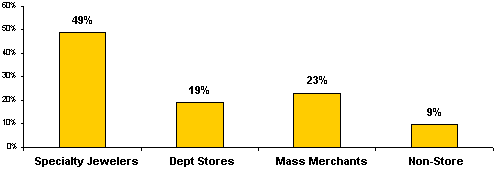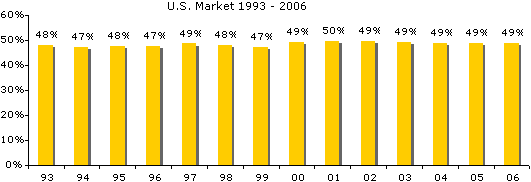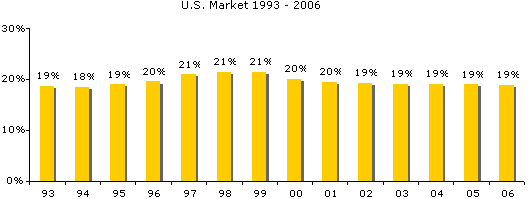IDEX Online Research: Specialty Jewelers at the End of the Rainbow
June 27, 07
American shoppers looking for the proverbial pot of gold go to specialty jewelers first. Specialty jewelry merchants sell about 49 percent, by value, of all the gold jewelry purchased by U.S. consumers.
Further, specialty jewelers’ market share of the gold jewelry market remains relatively unchanged – it has been fluctuating between 48-49 percent since the early 1990s. This is in contrast to specialty jewelers’ overall market share which has steadily eroded over the past couple of decades.
This market share trend is not expected, since it appears that shoppers buy gold jewelry primarily as a fashion accessory. When most shoppers are asked where they buy fashion accessories, the mention department stores, mass merchants, and specialty apparel stores; specialty jewelers typically are not top-of-mind with consumers for fashion jewelry.
Why do consumers continue to shop for their gold jewelry at specialty jewelers? Interestingly, most specialty jewelers don’t typically have leading edge fashion jewelry in their stores. We speculate that it has to do with the integrity – or perhaps the lack of perceived integrity – of other retailers. If consumers shop in a self-service environment, or in an environment where sales people are not well-trained (think Wal-Mart), they really can’t be sure that they are getting the genuine article. While we argue that consumers don’t shop for gold jewelry as an investment, there is at least some minimal need to be sure that they are getting what they are paying for. And the only sure way to get the “real thing” is to buy from a specialty jeweler.
The graph below summarizes the retail gold jewelry market share which each major merchant had in 2006.
| Gold Jewelry Market Share by Retail Channel |
The following table summarizes the revenue numbers from which the graph above was constructed.

Specialty Jewelers’ Market Share Holding Steady
In contrast to their slipping market share for most jewelry categories, specialty jewelers have held their market share steady at about 48-50 percent over the past two decades. The following graph illustrates the market share of specialty jewelers from 1993 through 2007.
| Gold Jewelry - Specialty Jewelers Market Share |
We note that there was a time in the late 1990s that specialty jewelers’ market share declined modestly to about 47 percent of total gold jewelry sales. However, their market share came roaring back in 2000 and 2001, and has held steady ever since.
Department Store Market Share – Ups and Downs
Department stores made a run to gain market share for gold jewelry in the late 1990s, and they successfully took share from specialty jewelers. However, it turned out that this was the proverbial flash in the pan for department stores. By the beginning of the current decade, their market share began to flag, and they sank back to market share levels which they had experienced at the beginning of the decade of the 1990s.
In part, this may have been related to the turmoil that department stores have been going through – mergers, acquisitions, and name changes dominated the industry. In addition, department stores were experimenting with ways to recoup market share that they were losing to off-mall retailers such as Target and others.
The graph below illustrates the gold jewelry market share of department stores in the U.S. market from 1993 through 2006.
| Gold Jewelry - Department Stores' Market Share |
Overall Market Share by Channel of Distribution Steady
While there have been minor fluctuations in gold jewelry sales by channel of distribution, each of the channels have held their relative market share fairly steady since 1993. Interestingly, the “non-store” channel has also held relatively steady. So far, online merchants have not made significant inroads into the gold jewelry market. We speculate that this is because gold jewelry is a small ticket impulse purchase: a woman sees something she likes and she buys it on the spot. With an average ticket under $100, she feels that she does not need to consult anyone prior to making the purchase.
The following graph illustrates market share by each of the four major channels of distribution for gold jewelry.
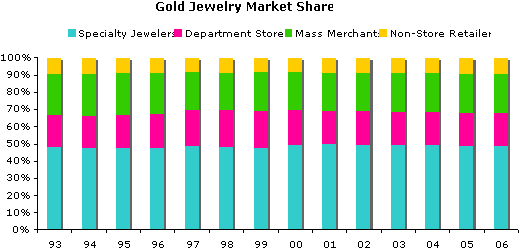
Source: World Gold Council
Distribution Channels for Gold Jewelry Similar to All Jewelry (More or Less)
About 48 percent of all jewelry sold in the U.S. is purchased from traditional specialty jewelry stores. This is only slightly less than the total of all gold jewelry – 49 percent – which is sold through traditional specialty jewelry stores.
The largest differences fall in the non-store category and the department store category.
- Department Stores – While 19 percent of all gold jewelry is sold through department stores, only 11 percent of all jewelry – diamonds, pearls, watches, etc. – is sold through department stores. This confirms that gold jewelry is basically a fashion accessory. Consumers typically look for fashion merchandise in department stores.
- Non-Store Channels – About 16 percent of all jewelry is sold through non-store retail outlets while only 9 percent of all gold jewelry is sold through this channel. Again, this confirms that gold jewelry is basically an impulse fashion purchase.
The graph below compares sales channels for “all jewelry” versus “gold jewelry.”
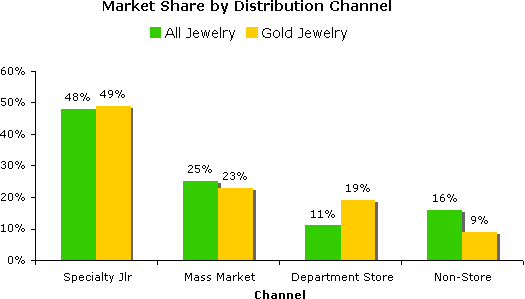 Source: World Gold Council & US Dept of Commerce |
